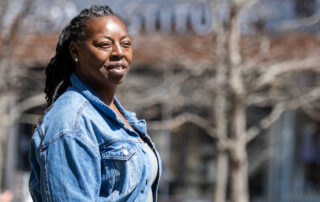Cartoonist Rube Goldberg rose to fame in the early 1900s for drawing whimsical cartoons that featured overly complicated machines designed to do a simple task, such as make breakfast, or close a door. They depicted a series of steps using everyday items in a pulley system, so that one action set off another action until the task is completed. The most common comparison to his work today is the board game “Mouse Trap.” Goldberg’s legacy has expanded beyond cartoons. An annual competition in Columbus, Ohio brings high school and college teams together to see who can build the best physical Rube Goldberg machine.
Four engineering students at the University of Wisconsin – Barron County decided to enter the 2016 college competition. The assignment was to open an umbrella. Team captain Dru Galetka had won the high school national title at nearby New Auburn High School. Galetka and friends Mathew Dentinger, Zachary Metza and Jacob Saxinger built a 45 step machine that paid tribute to inventor Nikola Tesla.
“So many of the things we have today are developed and derived from his research of electricity and we figured if we were going to do one of these machines, we might as well learn something that we maybe didn’t know,” Dentinger said.
The machine took observers through Tesla’s life. A large Tesla mannequin sat on a bench at the right edge of the machine. The process began with a baby carriage knocking over a series of books showcasing Tesla’s education. Tesla’s work included early experiments with X-ray technology and providing electricity for the 1893 World’s Fair. To represent this, the machine had a marble go through an X-ray machine, which eventually activated a lighted Ferris wheel.
Tesla was the first person to harness the power of Niagara Falls to produce electricity, so they sculpted a waterfall with a boat traveling across the river at the bottom. Two remote controlled race cars illustrated the War of Currents between Tesla and Thomas Edison. At the end of the machine’s run, one car activated a circuit that opened an umbrella in Tesla’s hand. Professor of Engineering Christa James-Byrnes said the machine took seven months to build.
“They worked the entire Christmas break, and the entire spring break, every day, so it was a long time – thousands and thousands of hours,” James-Byrnes said.
The team took their hand-crafted creation to Columbus, Ohio. The competition was fierce.
“We were up against the big dogs in the engineering world,” James-Byrnes said.
Their opponents included Purdue University, Penn State University, the University of California-Berkeley and a number of other nationally ranked engineering programs. Each team would deliver a presentation about their machine, then run it twice for the competition’s judges. Thousands of hours of work came down to two 45 second attempts. One failed step could derail all of their efforts.
“Dru, our team leader, he was basically green while that machine was going through,” Saxinger joked.
Their nerves wavered, but the machine didn’t.
“We had a flawless run, so that was really exciting, and they did their little Tesla thing and reset it,” James-Byrnes said, “They ran it again, and had another flawless run.”
The underdogs from UW-Barron County had surprised even themselves. They were the only team to have two errorless runs. They anxiously waited for the judges to name the winner. The announcement was made by Jennifer George, the granddaughter of Rube Goldberg.
“We were just sweating, nervous,” James-Byrnes said, “Then she said, ‘It’s my pleasure that this team won this award because I know the captain of the team. He’s already won the high school award.’”
George was referring to team captain Dru Galetka. UW-Barron County, enrollment 600, had defeated the best engineering schools in the country. They were national champions.
“We just went crazy and we were so excited,” James-Byrnes said.
“I was shocked, Zach was jumping around. Everybody was having a good time,” Saxinger said.
“It was pretty good feeling,” Galetka said, “I love being the underdog because nobody takes you seriously until you do something big, so it was a great feeling.”
For four college friends, it was an experience they’ll never forget.
“I’m so proud of them because it takes a lot of effort and energy and creativity,” James-Byrnes said, “They’re going to be great engineers.”
First Time Travelers
Traveling to the national championship provided an opportunity to see the country.










